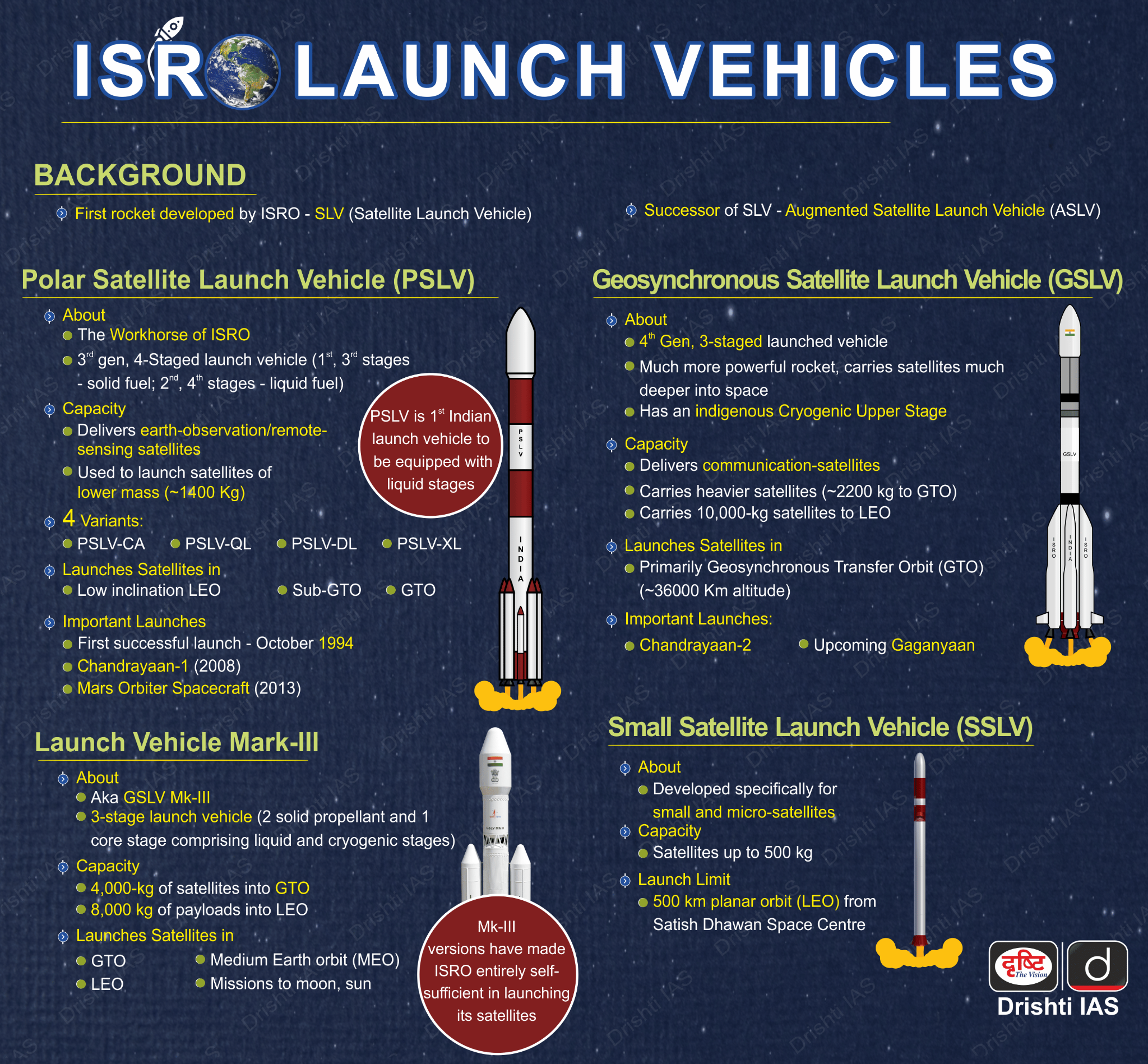Science & Technology
India's Space Launch Vehicle Supply and Demand Challenges
- 17 Jul 2024
- 8 min read
For Prelims: Indian Space Research Organisation, ISRO’s launch vehicle, SpaceX’s Falcon 9, geostationary transfer orbit
For Mains: Space Technology, India’s space launch services, Market for satellite-based services
Why in News?
Recently, the Chairman of the Indian Space Research Organisation (ISRO), stated that ISRO’s launch vehicle capability was three times the demand.
- This statement has sparked discussions among experts regarding the challenges facing India's space launch sector, as it appears to be struggling to create sufficient demand for its services.
What is India's Current Launch Vehicle Landscape?
- Current Launch Vehicles:
- Small Satellite Launch Vehicle (SSLV): Designed for launching small payloads.
- Polar Satellite Launch Vehicle (PSLV): Versatile for launching Earth Observation, Geo-stationary, and Navigation payloads.
- Known for its high success rate; considered the workhorse of ISRO.
- Geosynchronous Satellite Launch Vehicle (GSLV): Used for heavier payloads, particularly communication satellites weighing up to 2 tonnes.
- Launch Vehicle Mark-III (LVM-3): Capable of launching payloads up to 4-tonne class communication satellites and 10-tonne class payloads to Low Earth Orbits (LEOs).
- Limitations of Current Launch Vehicles:
-
Low Payload Capacity: India’s LVM-3 has less than one-third the capacity of China’s Long March 5. India’s current vehicles face limitations for more ambitious missions like Chandrayaan 4, necessitating upgrades and new vehicle developments.
- The country currently has a fleet of satellites for various applications such as communications, remote sensing, positioning, navigation and timing (PNT), meteorology, disaster management, space-based internet, scientific missions, and experimental missions. Additionally, it requires launch vehicles for upcoming space missions.
-
- Future Upgrades Needed: ISRO plans to upgrade the LVM-3 with a semi-cryogenic engine to increase its payload capacity to six tonnes to geostationary transfer orbit (GTO).
-
They also intend to develop a new launch vehicle called the Next Generation Launch Vehicle (NGLV), or Project Soorya, to carry 10 tonnes to GTO.
-
Currently, ISRO has only submitted a funding proposal for this project.
-
Additionally, the SSLV requires one more successful flight to build confidence for commercial launches of smaller satellites.
-
- Reliance on Foreign Launch Vehicles: For heavier payloads, India relies on international providers like Ariane V and SpaceX’s Falcon 9.
Why is there a Disconnect Between Supply and Demand?
- Historical Context: Previously, ISRO operated on a supply-driven model, launching satellites first and then seeking customers. This approach shifted post-2019 to a demand-driven model, which has led to an oversupply of launch vehicles relative to actual needs.
- The transition has led to a situation where demand for satellite services needs to precede satellite construction and launch.
- Challenges in Creating Demand:
-
Economic Factors: Launch vehicles are needed for satellites, with heavier ones used for national goals like lunar exploration and smaller ones for technology demonstration.
-
Satellites have finite operational lifespans, necessitating replacements that can create additional demand for launch vehicles. However, technological advancements have extended these lifetimes, creating uncertainty in the demand for launch vehicles.
-
Launch vehicles are also improving, with the ability to deliver multiple satellites in one launch, reusable rocket stages, and efforts to replace toxic fuels with greener alternatives.
-
ISRO is also investing in reusable rocket technology, which can reduce costs and improve profitability in the long term.
-
-
- Market Saturation: In some sectors, like internet services, existing options (e.g., affordable fibre and mobile internet) may overshadow the perceived need for space-based solutions. This reduces the urgency in developing satellite capabilities.
- Dependency on Government Initiatives: The Indian government wants the private sector to stimulate demand, build and launch satellites, provide customer services, generate revenue from launch services, and upskill workers.
- Private companies prefer the government to be their customer and to provide reliable regulations, aiming for a long-term source of revenue.
- Without proactive government initiatives to educate and stimulate demand among potential users, the gap between supply and demand is likely to persist.
-
Way Forward
- Educating Stakeholders: The key to creating demand is educating potential users (government entities, industries, and even ordinary citizens) about the benefits and applications of satellite services.
- The responsibility lies in both ISRO and the private sector to foster awareness and create a market for satellite-based services.
- Complex Customer Base: The demand for satellite services must be cultivated across diverse sectors, including agriculture, finance, and defence. Each sector has unique requirements and levels of awareness, complicating demand generation efforts.
- Cost-Effectiveness: Maintain India's edge as a cost-competitive launch service provider, attracting global customers seeking affordable access to space.
- Maintain ISRO's proven record of successful launches, fostering trust and confidence among potential clients.
- Government Push: The government can support private space ventures by providing seed funding, offering guaranteed launch slots for satellites, and increasing public awareness of the benefits of space-based applications.
- Collaboration: Foster collaboration with other space agencies for joint missions, technology exchange, and knowledge sharing. Encourage increased private sector involvement in satellite development and launch by creating a supportive regulatory environment.
Read more: Space Missions in 2024
|
Drishti Mains Question: Q. Discuss the current challenges facing India's space launch sector and suggest measures to bridge the gap between supply and demand. |
UPSC Civil Services Examination, Previous Year Question (PYQ)
Q. With reference to India’s satellite launch vehicles, consider the following statements: (2018)
- PSLVs launch the satellites useful for Earth resources monitoring whereas GSLVs are designed mainly to launch communication satellites.
- Satellites launched by PSLV appear to remain permanently fixed in the same position in the sky, as viewed from a particular location on Earth.
- GSLV Mk III is a four-staged launch vehicle with the first and third stages using solid rocket motors, and the second and fourth stages using liquid rocket engines.
Which of the statements given above is/are correct?
(a) 1 only
(b) 2 and 3
(c) 1 and 2
(d) 3 only
Ans: (a)







